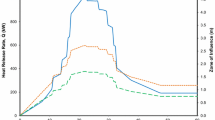Abstract
A general conceptual framework has been developed as an aid to discussions of alternative approaches to fire risk analysis. The purpose is to show how each alternative seeks to address a few common concerns. Basic concepts and key elements — notably scenario structures, appropriate probability functions, and security and outcome measures — are defined and discussed, as are types of modeling approaches. Anumber of diverse examples are then presented using the framework to illustrate its value in making comparisons.
Similar content being viewed by others
References
F. B. Clarke, R. W. Bukowski, S. W. Stiefel, J. R. Hall, Jr., and S. A. Steele, “A Method to Predict Fire Risk: The Report of the National Fire Protection Research Foundation Risk Project,”Report to the National Fire Protection Research Foundation (NFPRF), Quincy, Massachusetts: NFPRF, 1990, (Developed at Benjamin/Clarke Associates, National Institute of Standards and Technology, and the National Fire Protection Association).
T. Tanaka, “Basic Structure of The Evacuation Safety Design Method,”The Proceedings of the 9th Joint Panel Meeting of the UJNR Panel on Fire Research and Safety, NBSIR 88-3753, Gaithersburg, Maryland: National Bureau of Standards (April 1988) (Developed by Ministry of Construction).
M. Kazarians, N. O. Siu, and G. Apostolakis, “Fire Risk Analysis for Nuclear Power Plants: Methodological Developments and Applications”Risk Analysis,5,1, pp. 33–51 (1985).
S. G. Helzer, B. Buchbinder, and F. L. Offensend, “Decision Analysis of Strategies for Reducing Upholstered Furniture Fire Losses,”NBS Technical Note 1101, Washington: National Bureau of Standards (June 1979).
M. Tsujimoto and K. Shida, “An Estimation Method on Life Risk in Case of Hospital Fires,” The Proceedings of the 10th Joint Panel Meeting of the UJNR on Fire Research and Safety, Tsukuba, Japan: Building Research Institute, forthcoming.
NFPA 550,Firesafety Concepts Tree, Developed by the NFPA Technical Committee on Systems Concepts for Fire Protection in Structures, National Fire Protection Association, Quincy, Massachusetts (1986).
W. C. T. Ling and R. B. Williamson, “Using Fire Tests for Quantitative Risk Analysis,” Fire Risk Assessment, ASTM STP 762, Philadelphia: American Society for Testing and Materials (1982).
J. A. Swartz et al, “Final Technical Report on Building Fire Simulation Model,” Quincy, Massachusetts: National Fire Protection Association (May 1983).
A. Sekizawa and T. Jin, “Fire Risk Evaluation Method for Multi-Occupancy Buildings,” The Proceedings of the 9th Joint Panel Meeting of the UJNR Panel on Fire Research and Safety, NBSIR 88-3753, Gaithersburg, Maryland: National Bureau of Standards (April 1988) (Developed by Fire Defense Agency, Ministry of Home Affairs).
Discussion based on characterization in J. M. Watts, Jr., “Fire Risk Assessment Schedules,”The SFPE Handbook of Fire Protection Engineering, National Fire Protection Association, Quincy, Massachusetts (1988).
B. Strickland, “Fire Risk Assessment,”Fire Command (August and September 1987).
Author information
Authors and Affiliations
Rights and permissions
About this article
Cite this article
Hall, J.R., Sekizawa, A. Fire risk analysis: General conceptual framework for describing models. Fire Technol 27, 33–53 (1991). https://doi.org/10.1007/BF01039526
Issue Date:
DOI: https://doi.org/10.1007/BF01039526



